Grafting Vegetables Offers Increased Yields, Less Crop Stress, And More
Disease resistance. Less crop environmental stress. Greater vigor. Reduced pesticide applications. Those are just a few of the benefits that grafted vegetable plants can provide growers.
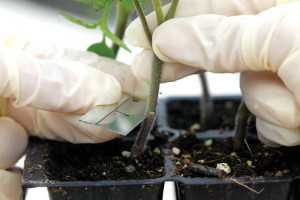 With the support from USDA (Specialty Crop Research Initiative), participating universities, growers, and industry partners, research teams are determining when, where, and how grafted plants can most enhance the success of U.S. commercial vegetable operations.
With the support from USDA (Specialty Crop Research Initiative), participating universities, growers, and industry partners, research teams are determining when, where, and how grafted plants can most enhance the success of U.S. commercial vegetable operations.
To read more about grafting’s benefits, go to http://bit.ly/1igiHbN or visit the vegetable grafting research-based portal at www.vegetablegrafting.org.
Here are some highlights straight from researchers on the outcome of some recent grafting projects.
Grafted tomatoes offer an alternative strategy for soil-borne pest management.
Josh Freeman, University of Florida

Josh Freeman is an assistant professor of horticulture, vegetable specialist, University of Florida.
Over the last several years, our research group, which includes Mathews Paret and Steve Olson, both of the University of Florida, has concentrated on managing soil-borne pests with grafted tomatoes in open field production. In our opinion, the main reason grafted tomatoes will be grown in this production system is soil-borne disease.
Our first field trials focused on managing bacterial wilt in mature green type tomatoes. In trial locations in Florida and Virginia from 2010 to 2012, we evaluated the resistance in seven rootstocks. These rootstocks were evaluated in the greenhouse, inoculated field, and naturally infested field experiments.
Our research showed even under extreme pressure in naturally infested fields, disease incidence in our best rootstocks could be held to around 10% whereas non-grafted susceptible varieties exhibited more than 85% incidence. This amount of resistance led to tremendous yield increase with resistant rootstocks. Our most resistant rootstocks were BHN 1054 and BHN 998 from BHN Seed, and Cheong Gang from Seminis Vegetable Seeds.
From these experiments we used some of the most bacterial wilt-resistant rootstocks and tested their resistance to root-knot, which is caused by root-knot nematodes. These experiments were also conducted in a greenhouse and open-field setting in both Florida and Virginia in 2011 and 2012.

The plot on the left (204) is the un-grafted susceptible tomato plants and on the right is the same susceptible scion grafted to the resistant rootstock BHN 1054.
Photo credit: Josh Freeman
Results showed the root-knot resistance to be very good in several of the bacterial wilt resistant rootstocks. RST-04-106T from DP Seeds, BHN 998, and BHN 1054 exhibited significantly less root galling compared to a susceptible variety. Plants grafted to resistant rootstocks yielded greater when root galling was severe. Cheong Gang is also reported to have resistance to root-knot but was not included in these experiments.
The information gathered from these tests illustrates that there are rootstocks available with robust resistance packages suitable for open-field tomato production. In an era when many growers can no longer justify the use of soil fumigants, grafted tomatoes offer an alternative strategy for soil-borne pest management. Our current research focuses on integration of grafting with other tools for soil-borne disease management, and optimizing effectiveness of grafting in the presence of pest complexes.
Storing grafted plants at low temperatures saves on labor, shipping grafted cuttings saves on cost, and an automation process may save on both.
Chieri Kubota, University of Arizona
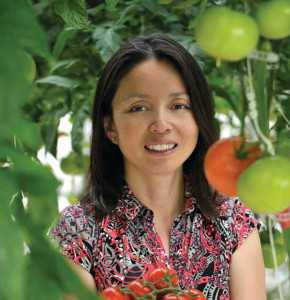
Chieri Kubota is a professor in the School of Plant Sciences at the University of Arizona.
Some of my research involved improving propagation technology for grafting while making grafted seedlings available nationwide. This exercise was a three-part process. The tasks included: determine how long grafted plants can remain in low-temperature storage to help manage labor, increase distribution methods for grafted plants, and evaluate an automated grafting process.
Currently there are no large grafting nurseries in the U.S. so growers interested in using grafted vegetable plants have to determine who will sell the grafted plants to them at a reasonable price.
Part one in the process involved low-temperature storage of grafted plants to reduce labor and subsequently reduce costs. The plan was to store the plants for a few weeks so the grafting task is spread over several weeks, negating the need to hire a large number of temporary workers to get the job done in just a couple of weeks.
This initial phase of the research focused on the storability of various grafted vegetables, both scions and rootstocks. The outcome was that plants grafted with strong rootstock can be stored for a longer period of time.
Recommendations are as follows. Tomato seedlings can be stored at 50° to 54°F degrees under dim light for up to four weeks. For cucurbits, it depends on species and rootstock. Some can be stored for four weeks while others only for one week. The shortest storage time is watermelon, but when watermelon is grafted on squash rootstock, seedlings can be stored for up to two weeks. Other cucurbits, like cucumber and muskmelon, can be stored for four weeks at 54°F under dim light.
The second part of the process, developing ideas and technology to distribute grafted plants, is aimed at helping propagators sell plants across the country. Right now, they are limited and can only sell typically within a 500-mile radius because of the expense involved with shipping plants.
The proposed technology does away with shipping whole plants and just sending grafted cuttings.
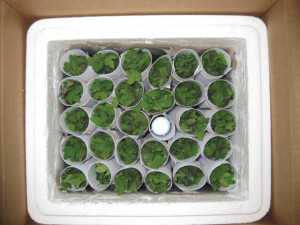
More than a thousand unrooted grafted cuttings are packed in a small box for shipping.
Photo credit: Dr. Chieri Kubota, the University of Arizona
After grafted plants heal, propagators then cut shoots at the soil surface so there are no roots. The shoots or cuttings can then be packed by the thousands into small boxes and shipped across the country in a day, costing about 1¢ to 2¢ per plant, depending on the number of cuttings sent. Once the recipient receives the cuttings, a new substrate must be added allowing the crop to root easily.
The third part of the process involved the introduction of automation in the grafting process. An industrial engineer at the University of Arizona, Dr. Young Jun Son, developed a simulation model of a nursery operation from soil preparation to moving grafted plants to a greenhouse just prior to shipping.
The research group is now ready to test various scenarios to evaluate the impact of new technologies in the grafting process, such as automation. Computer simulation will determine the optimized ratio of manual grafting and automated grafting.
With the phaseout of methyl bromide, grafting is a viable option for watermelon growers dealing with Fusarium wilt. The goal is to make grafting cost-effective.
Richard Hassell, Clemson University

Richard L. Hassell is a professor, vegetable physiology and vegetable Extension specialist at Clemson University; and Shawna Daley is a Masters candidate at Clemson.
As methyl bromide has been phased out, grafting cucurbits onto disease-resistant rootstocks is the only option for growing watermelon in fields with Fusarium wilt. Because the rootstocks are not hosts for the disease, grafting onto these rootstocks protects the crop from soil-borne diseases and brings other benefits, as well.
The robust rootstock also provides enough nutrients to the watermelon scion to
increase fruit number, size, and nutritional
value. Grafted watermelon lasts longer
in the field without going over-ripe, so a
grower can hold his crop until the price is high without losing fruit quality.
However, producing grafted plants can be very costly, especially in labor required to control regrowth from the rootstock. Regrowth from the rootstock plant competes with the watermelon scion for light and nutrients. If regrowth occurs early, the graft will be lost, and if it occurs later in the field, yields will suffer.
Our research is aimed toward improving the watermelon grafting process by overcoming the challenge of rootstock regrowth to make grafting cheaper and more efficient. We are researching a compound that burns out just the squash meristem, and leaves the squash plant ready for grafting, without any regrowth. When we treat the plants with this compound and then leave them in the greenhouse over time, the rootstocks store up carbohydrates that can be used for energy.
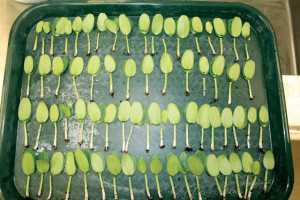
These rootstock plants are being prepared for measurement and carbohydrate analysis. Photo credit: Shawna Dailey
The more energy a rootstock has, the better the graft heals and the faster the rootstock re-roots. The treatment also increases the grafting window of these rootstocks from just a few days to three weeks.
One of the most exciting aspects that we are researching is a new, more efficient grafting method that is possible as a result of the accumulated carbohydrates. A rootstock’s cotyledons are a lot like human kidneys: We can still live if we lose one, but not both. In the same way, the rootstock must have at least one cotyledon remaining when it is grafted, to provide the energy to heal the graft. After the treatment, the rootstocks store so much energy that they no longer rely on the energy provided by the cotyledons, and can be grafted without them.
This is a much easier and more efficient grafting method because it completely eliminates suckering, requires less space, and is more cost-effective. The rootstock treatment and grafting procedure we have developed will make the grafting process more efficient and effective and, ultimately, more beneficial to the grower.
Grafted tomato plants show greater yield and improved nitrogen use efficiency compared to non-grafted plants in a nitrogen fertilization rate study.
Xin Zhao, University of Florida

Xin Zhao is an associate professor in the Horticultural Sciences Department at the University of Florida
A two-year study was conducted to determine the effects of different irrigation regimes and nitrogen rates on yield, irrigation water use efficiency, and nitrogen (N) use efficiency of grafted tomato plants, in comparison with non-grafted plants, grown with drip irrigation in sandy soils in Northern Florida during the 2010 and 2011 spring seasons. The determinate tomato cultivar, Florida 47, was grafted onto two interspecific hybrid rootstocks, Beaufort and Multifort, respectively.
Grafted and non-grafted Florida 47 plants were grown in a fumigated (to minimize interference of soil-borne pest factors) field under 12 combinations of two drip irrigation regimes and six nitrogen rates. Grafting increased total and marketable fruit yields by approximately 32% and 37%, respectively, averaged over the two seasons.
Interestingly, grafted plants showed greater potential for yield improvement with increasing N rates compared to non-grafted plants. Grafting led to increases in fruit number per plant and average fruit weight in both years. Grafted tomato plants with the two rootstocks demonstrated significantly enhanced irrigation water and N use efficiency in field production.
In this study, we also carried out a cost-benefit analysis of grafted tomato production under the standard irrigation and fertilization practices. Using grafted transplants resulted in an increase of production cost by $3,020 per acre given that the estimated cost of grafted transplants was 67¢ per plant versus non-grafted transplants at 15¢ per plant.
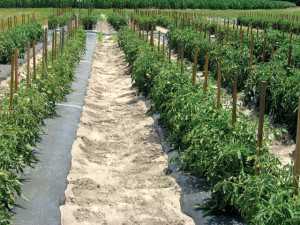
This image shows tomato plants with two irrigation regimes (50% and 100% of recommended regime) and six N rates (25%, 50%, 75%, 100%, 125%, and 150% of suggested total N rate).
Photo credit: Desire Djidonou
Owing to the improved fruit yields, fruit harvest and marketing costs were also higher in grafted tomato production. The total increase of production costs for using grafted plants was estimated at $4,488 to $5,190 per acre, depending on the rootstock and growing season. However, the increase in marketable fruit yield generated significant gross returns to offset the higher costs of grafted tomato production.
With the use of grafted tomato transplants, the net farm return was increased by $253 to $2,458 per acre, in comparison with non-grafted tomato production. Furthermore, grafted tomato production would be more profitable as the costs of grafted transplants decreased and the market tomato prices increased.
Determining the economic feasibility is essential for providing recommendations. We hope to collect more data on fruit yield, disease control, production budget, and net returns from different commercial tomato production scenarios involving a range of tomato scion and rootstock cultivars in the future.










